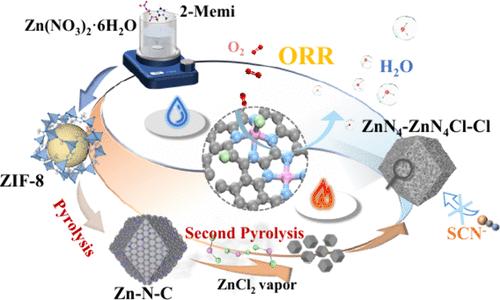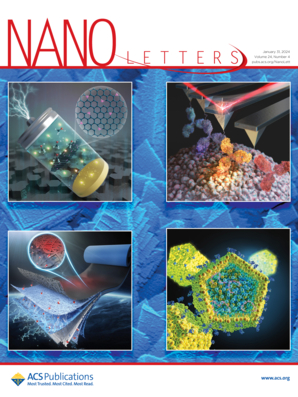通过高壳金属和非金属单原子精细设计 ZnN4 的 d 轨道空位,实现高效抗中毒 ORR
IF 9.6
1区 材料科学
Q1 CHEMISTRY, MULTIDISCIPLINARY
引用次数: 0
摘要
原子分散的金属氮碳(M-N-C)材料是一种活性氧还原反应(ORR)催化剂。在 M-N-C 催化剂中,ZnN4 单原子催化剂(SAC)由于几乎是全 3d10 电子构型,因此对氧的活化不足,ORR 活性较低。为了精细设计 ZnN4 的 d 轨道空位,我们结合了高壳金属和非金属 SAC 作为电子调节器,即 ZnN4Cl 和碳空位寄主 -Cl 主题,它们与 ZnN4 相比具有互补的电子吸收能力。在这种情况下,与未修饰的 ZnN4(E1/2 = 0.822 VRHE)相比,ZnN4 的 ORR 活性显著增强,半波电位(E1/2)达到 0.912 VRHE,同时具有很强的耐久性(10,000 个电位循环后的活性损失可以忽略不计)。特别是,工程化的 ZnN4 具有很强的抗 SCN 中毒能力,这在 M-N-C SAC 中是很少见的。我们的研究结果表明,将高壳金属和非金属 SAC 结合起来,可以将金属中心的 d 轨道空位精细地设计到最佳状态,从而从本质上提高它们的催化性能。本文章由计算机程序翻译,如有差异,请以英文原文为准。

Fine Engineering of d-Orbital Vacancies of ZnN4 via High-Shell Metal and Nonmetal Single-Atoms for Efficient and Poisoning-Resistant ORR
Atomically dispersed metal–nitrogen–carbon (M–N–C) materials are active oxygen reduction reaction (ORR) catalysts. Among M–N–C catalysts, ZnN4 single-atom catalysts (SACs) due to a nearly full 3d10 electronic configuration insufficiently activate oxygen and display low ORR activity. To finely engineer d-orbital vacancies of ZnN4, we combine high-shell metal and nonmetal SAs as electronic regulators that are ZnN4Cl and carbon vacancy-hosted −Cl motifs, which show complementary electron-withdrawing capacities versus the ZnN4. Under that, the ZnN4 exhibits significantly enhanced ORR activity with a half-wave potential (E1/2) of 0.912 VRHE relative to the unmodified ZnN4 (E1/2 = 0.822 VRHE) and simultaneously robust durability (negligible activity loss after 10,000 potential cycles). Particularly, the engineered ZnN4 possesses high resistance to SCN– poisoning, which is rarely achieved among M–N–C SACs. Our works show that combining high-shell metal and nonmetal SAs can finely engineer d-orbital vacancies of metal centers to an optimal state, thereby intrinsically enhancing their catalytic performance.
求助全文
通过发布文献求助,成功后即可免费获取论文全文。
去求助
来源期刊

Nano Letters
工程技术-材料科学:综合
CiteScore
16.80
自引率
2.80%
发文量
1182
审稿时长
1.4 months
期刊介绍:
Nano Letters serves as a dynamic platform for promptly disseminating original results in fundamental, applied, and emerging research across all facets of nanoscience and nanotechnology. A pivotal criterion for inclusion within Nano Letters is the convergence of at least two different areas or disciplines, ensuring a rich interdisciplinary scope. The journal is dedicated to fostering exploration in diverse areas, including:
- Experimental and theoretical findings on physical, chemical, and biological phenomena at the nanoscale
- Synthesis, characterization, and processing of organic, inorganic, polymer, and hybrid nanomaterials through physical, chemical, and biological methodologies
- Modeling and simulation of synthetic, assembly, and interaction processes
- Realization of integrated nanostructures and nano-engineered devices exhibiting advanced performance
- Applications of nanoscale materials in living and environmental systems
Nano Letters is committed to advancing and showcasing groundbreaking research that intersects various domains, fostering innovation and collaboration in the ever-evolving field of nanoscience and nanotechnology.
 求助内容:
求助内容: 应助结果提醒方式:
应助结果提醒方式:


